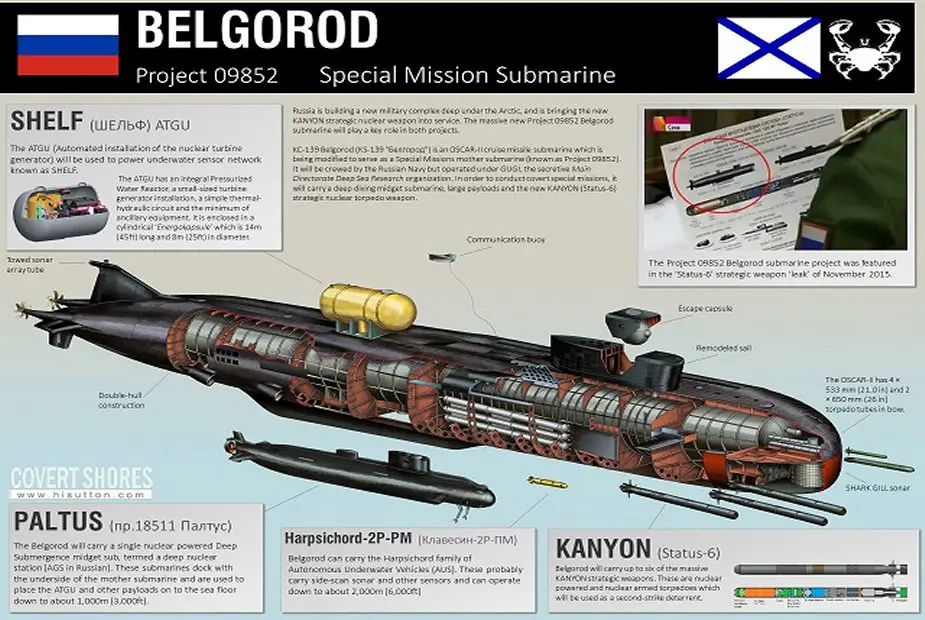Breaking news
Russia launched a Project 09852 Belgorod submarine.
Russia`s naval shipbuilding industry has launched a Belgorod nuclear-powered special submarine of Project 09852, laid down several surfaced combatants, and linked the sections of a Corvette, according to the country`s officials.
 Artist impression of Project 09852 Belgorod (Picture Source: covert shores)
Artist impression of Project 09852 Belgorod (Picture Source: covert shores)
"I hope that the planned construction terms will be kept. [Those programs] are vitally important for the strengthening of our fleet, maintenance of our security, and protection of the country`s interests in blue and green waters of the World Ocean," said President of the Russian Federation Vladimir Putin during an official ceremony.
According to him, the Navy (Voyenno-Morskoy Flot, VMF) has received more than 80 naval platforms, including three nuclear-powered ballistic missile submarines, seven nuclear-powered attack underwater combatants and diesel-electric submarines, and 21 surface ships since 2012. "I would point out that we have sustained high rates of the Navy`s rearmament in recent years … We will support our shipbuilding industry and shore up its scientific, human, and technological potential," said Putin.
The Sevmash Shipyard has launched the Project 09852 ‘Belgorod’ special submarine. "The enterprise will accomplish all the construction works in a timely manner and at a high level," said Director General of the company Mikhail Budnichenko.
The Project 09852 ‘Belgorod’ nuclear-powered special submarine has been developed on the base of the Project 949A (Oscar-II) nuclear-powered cruise missile submarine by the Central Design Bureau for Marine Engineering Rubin (a subsidiary of the United Shipbuilding Corporation). According to the open sources, the new underwater combatant is intended for the Navy`s Main Department of Deep-Water Researches (GUGI). Some specialists suggest that the submarine is designed for various scientific deep-water missions, search-and-rescue operations, installation and checking of underwater hardware, tests of scientific equipment, and monitoring of underwater transport lines. The platform is believed to carry the Poseidon unmanned underwater vehicles (UUVs) and other UUVs. According to the open sources, the Project 09852 submarine has a full displacement of some 24,000 t and is 184 m long and 18.2 m wide. The ship produces an underwater speed of 33 knots.
The ‘Belgorod’ submarine was laid down at the Sevmash Shipyard on July 24, 1992. In 1994, her construction was ceased. After the loss of the Project 949A SSGN ‘Kursk’ in 2000, the works were resumed; they ceased again in 2006. In 2012, the platform was re-laid down as a Project 09852 submarine. Compared to the Project 949A, the new ship`s length increased by 30 m due to the installation of a new compartment and redesigning of the central part. Therefore, ‘Belgorod’ will be the biggest submarine in the world.
The Project 949A ship is powered by two OK-650V liquid water-cooled reactors with a power output of 100,000 hp. The submarine features low acoustic signature, while her main components have building-block design and two-cascade shock-absorbing system. Specialists believe that the industry paid specific attention to the reduction of acoustic signature.
During the rebuilding process, the Project 949A SSGN`s armament suite (24 P-700 Granit (SS-N-19 Shipwreck) ASMs in inclined launchers) was removed. The original submarine`s nose compartment had two 650 mm and four 533 mm torpedo tubes. It is unclear whether ‘Belgorod’ has retained these weapons or larger tubes for the Poseidon strategic UGV have replaced them. According to the open sources, the Project 09852 submarine can carry other UGVs, namely, Klavesin or even nuclear-powered deep-water stations.
© Copyright 2019 TASS. All rights reserved. This material may not be published, broadcast, rewritten or redistributed.




























